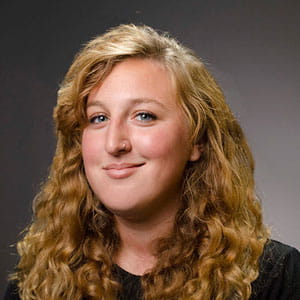Drexel in Philly: The Founder’s Center City
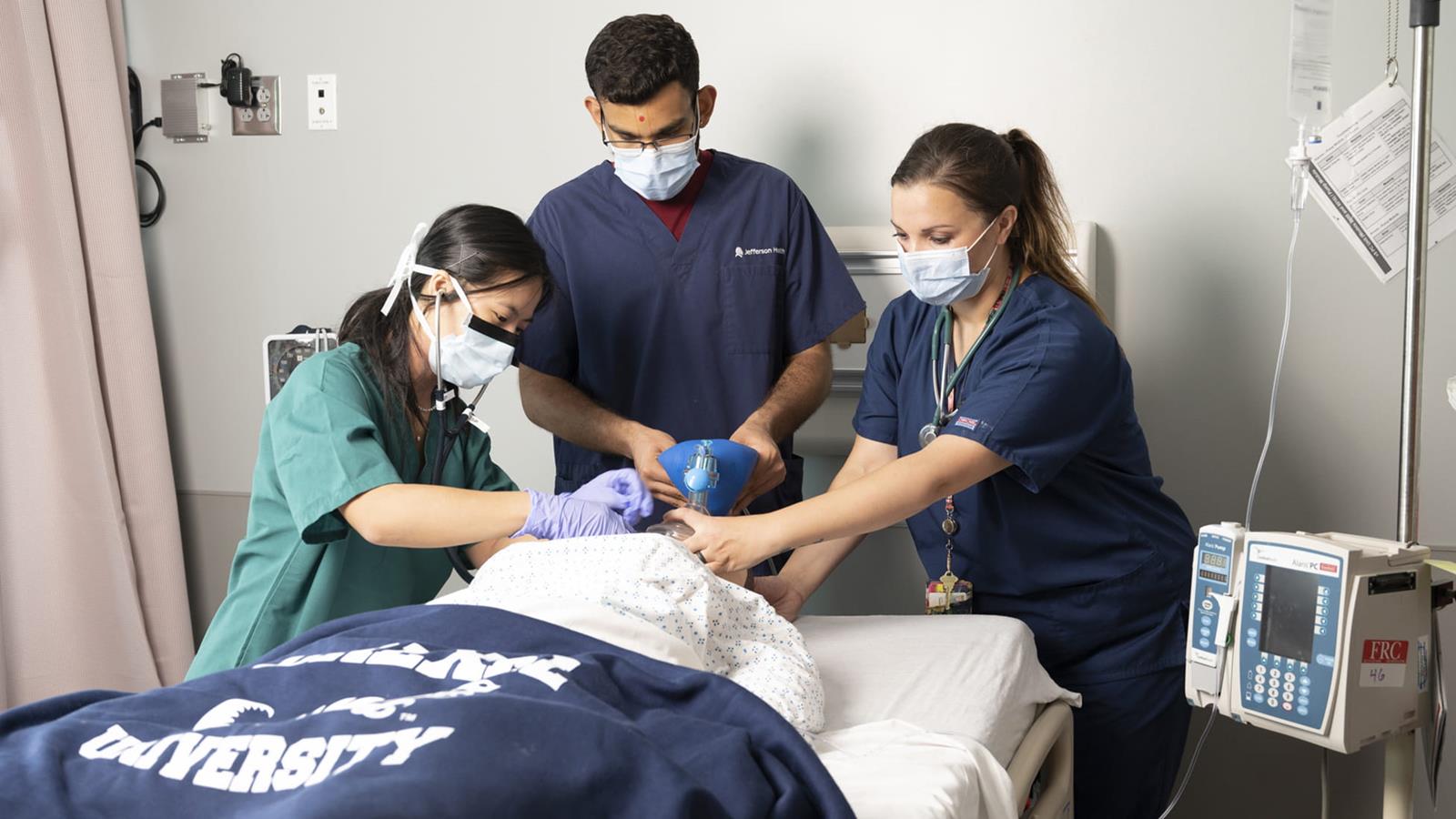
- Drexel’s College of Nursing and Health Professions Receives $1 Million for Scholarships from the Bedford Falls Foundation – DAF to Address Nursing Workforce Shortage
- Laura Turner to Join Drexel University as Senior Vice President for Institutional Advancement
- When the World Changes, Drexel Changes With It
- U.S. Department of Education Provides Final Approval of Drexel and Salus Merger

Drexel University’s founder, Anthony J. Drexel (1826–1893), lived his entire life in Philadelphia. He worked in the Drexel & Co. banks in Old City, where he was born; helped develop an iconic institution in Center City, where he lived as a teenager and young husband; presided over a groundbreaking public art organization to beautify Fairmount Park; and raised his family in West Philadelphia, where he founded the then-Drexel Institute of Art, Science and Industry in 1891.
More than 130 years after his death, Anthony’s impact and legacy can still be felt across the city — and you can see it, too. This “Drexel in Philly” series explores some of the historic buildings, institutions, public art and other places that Drexel’s founder — and his large family — built and supported.
This story explores his Center City connections, and you can also read about his ties to West Philly, Old City and Fairmount Park.
While Drexel University’s founder, financier and philanthropist Anthony J. Drexel, was born in Old City and primarily lived in West Philadelphia, he once was a resident of Center City. He and his family lived on Rittenhouse Square, as depicted in a 1960s Disney movie; you might have shopped or attended concerts inside their former homes. And Anthony’s business operations, as well as the religious beliefs of his family members, helped create some of the area’s notable institutions.
There are several places you can visit today that bear some trace of Anthony and/or his family members:

An 1893 lithograph from the Library of Congress that had been created for the Reading Terminal’s opening, clearly showing the train shed designed by Wilson Brothers & Company.
Reading Terminal Market and Pennsylvania Convention Center: Then
The Drexel & Co. bank started in 1838 by Anthony’s father Francis Martin Drexel financed the growth of some of the country’s biggest railroad companies. Longtime client Reading Railroad declared bankruptcy in 1888 partly because of a president that Anthony helped remove; during the reorganization, Anthony negotiated a $24 million loan for the company (worth more than $797 million in 2025). In 1891, the same year that Anthony founded the then-Drexel Institute of Art, Science and Industry, he negotiated an $8.5 million loan (worth $294 million today) for the construction of the Reading Terminal in Philadelphia.
The complex on the 1100 block of Market St. originally housed the Reading Railroad’s main train depot, passenger station, company headquarters and the Reading Terminal Market. The train shed was designed by the same Wilson Brothers & Company behind the University’s Main Building and Anthony’s Old City office complex known as the Drexel Building.
Reading Terminal officially opened in January 1893, but Anthony worked on the company’s reorganization for months afterwards. Four days before dying of a heart attack that June, he received notice that his most recent financial proposal had been rejected.
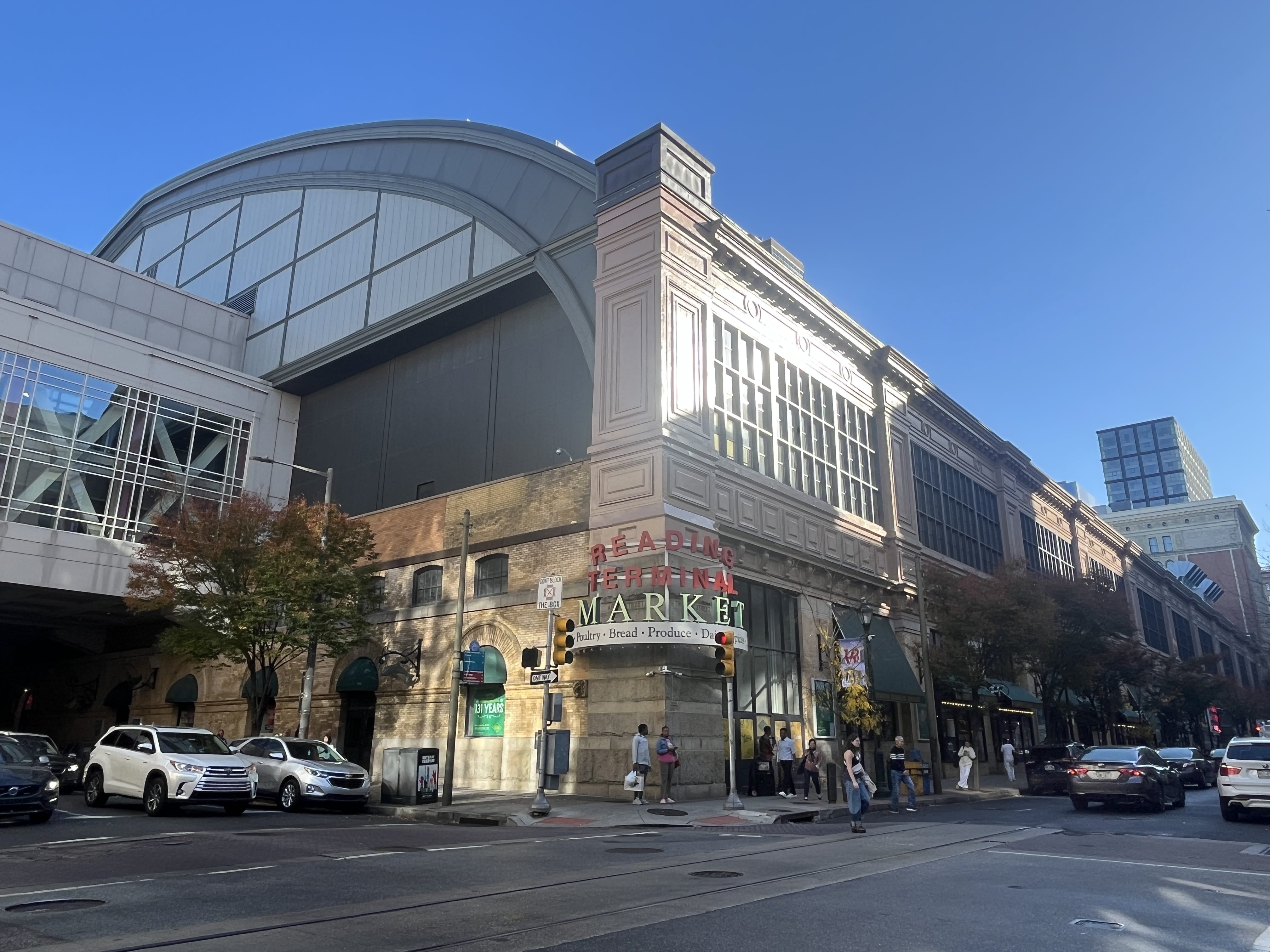
Reading Terminal Market and Pennsylvania Convention Center: Now
Reading Railroad left Reading Terminal in the 1980s after bankruptcies, mergers and decreased operations.
The complex later became the Pennsylvania Convention Center, which now occupies the Wilson Brothers-designed train shed and is managed by a private company, and the Reading Terminal Market, now managed by a nonprofit.
Both areas are popular destinations not just in the neighborhood, but in the entire city; Reading Terminal Market currently has over 75 vendors and the Convention Center hosts major events every year.

The exterior of the Cathedral Basilica of Saints Peter & Paul, including the copper on the roof supposedly donated by the founder’s older brother.
Cathedral Basilica of Saints Peter & Paul: Then
While Anthony became Episcopalian after marriage, his older brother Francis Anthony “Frank” Drexel was a prominent, socially conscious Catholic. Frank helped fund the construction of the Cathedral Basilica of Saints Peter & Paul, which was founded in 1864; he reportedly donated the roof’s copper. Frank also bought an organ used in the cathedral and occasionally filled in for the organist when needed.
Frank and his second wife Emma Bouvier Drexel (great-grandaunt of future First Lady Jacqueline Bouvier Kennedy Onassis) financially supported local Catholic institutions, and Emma and the children — sisters Elizabeth and Katharine and half-sister Louise — provided food, medicine and money (about $20,000 each year) to the poor three times a week from their 1503 Walnut St. townhouse. The family attended mass at the Cathedral, and Frank served as an adviser to Archbishop Patrick John Ryan.
After Emma died in 1883 and Frank died in 1885, their daughters donated an altar memorializing their parents that was installed at the church.
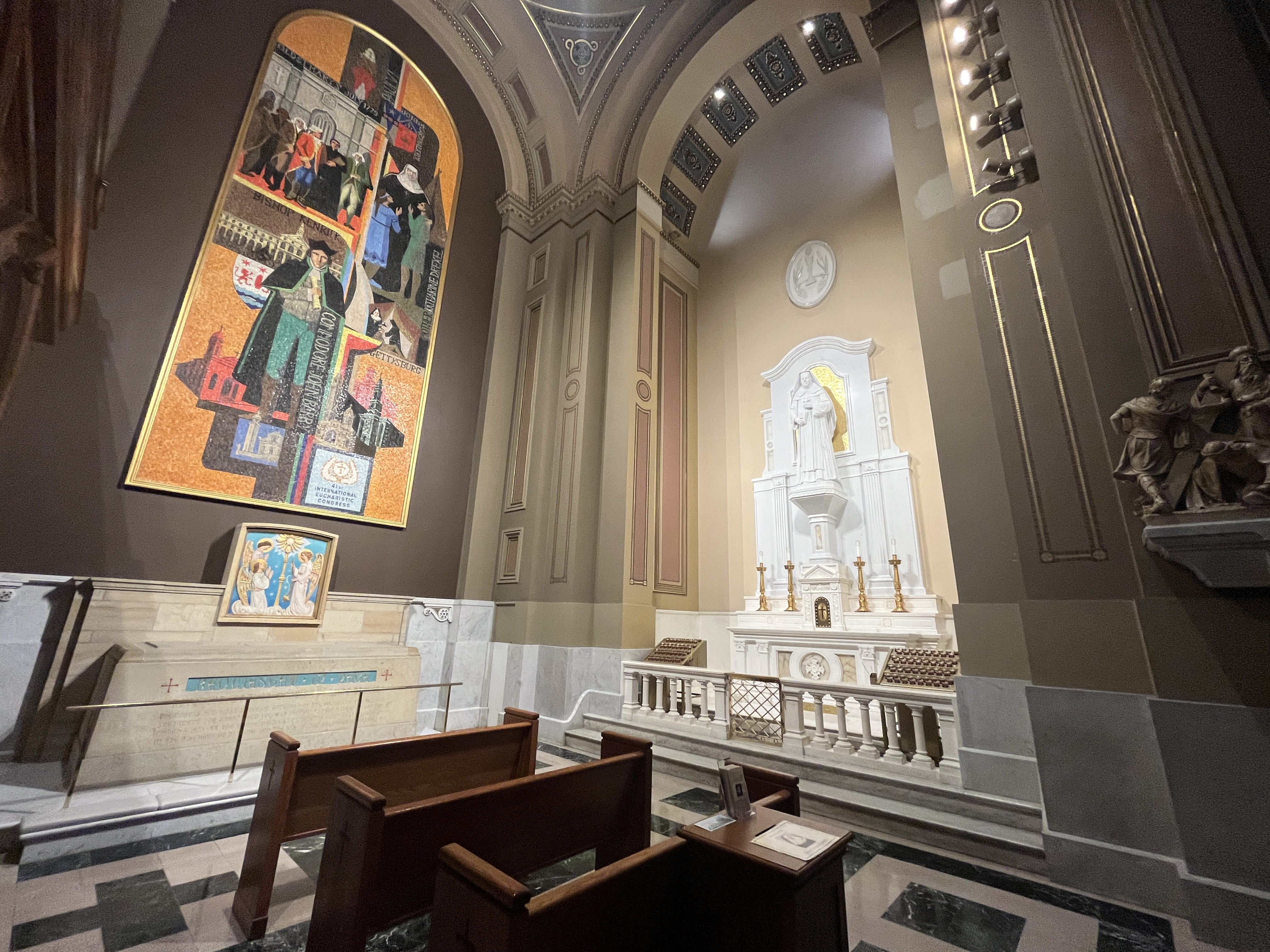
The Shrine to Saint Katharine Drexel, on the right, was dedicated in 2009, and the marble statue is on top of the 19th century altar donated by Saint Katharine and her sisters in honor of their deceased parents. The sacred remains of Saint Katharine Drexel, left, were installed in 2018; the mosaic above it was created in 1975 (a year after the first miracle ascribed to her) and depicts the Catholic Church’s history in Pennsylvania, including then-Mother Katharine Drexel in the top right.
Cathedral Basilica of Saints Peter & Paul: Now
Katharine renounced her heiress lifestyle to become a nun in 1889, and received religious counsel from Archbishop Ryan, who officiated her final vows as well as her sisters’ weddings. Mother Katharine Drexel spent the rest of her life with the Sisters of the Blessed Sacrament congregation she founded, using her inheritance to provide care and fund schools for the poor and the oppressed, mostly in Black and Native American communities.
After her death in 1955, she was laid to rest at the Sisters of the Blessed Sacrament Motherhouse in Bensalem, Pennsylvania, following funeral services at the Cathedral Basilica. She was canonized as Saint Katharine Drexel in 2000, becoming the second American-born saint and fourth overall American saint.
In 2018, after the Sisters of the Blessed Sacrament sold the property, her sacred remains were moved to the Cathedral Basilica adjacent to her parents’ altar. Both can be viewed today.

Curtis Institute of Music: Then
Anthony’s youngest son George W. Childs Drexel and his wife Mary Stretch Irick Drexel were one of Anthony's three children to live in the “Drexel Colony” on 38th and Walnut streets, where Anthony built homes for his family; George, Anthony J. Drexel, Jr. and Frances “Fannie” Drexel Paul each had a home on the same block as the residence where Anthony and his wife Ellen Rozet Drexel lived and raised their children. After Anthony died (two years after Ellen), George and Mary moved to the southeast corner of the fashionable Rittenhouse Square.
Their limestone Beaux-Arts mansion was designed by the Peabody and Stearns architecture firm; George and Mary also hired them to design their Maine summer residence now owned by actor John Travolta. The Curtis Institute holds archival photos from 1900 showing the lush interior of the Drexels’ Rittenhouse mansion.
Curtis Institute of Music: Now
In 1924, Mary Louise Curtis Bok purchased the mansion, along with two adjacent properties, for the Curtis Institute of Music she opened that year. The Drexels arranged for Edwin Blashfield (the artist behind the mural dedicated to Anthony in today’s Philadelphia Episcopal Cathedral) to paint a mural on one room’s ceiling as a gift; it featured figures representing music, art and poetry, among other concepts. In 1895, they had purchased a Blashfield-painted Steinway piano, which they kept.
Mary Louise named the school for her father, the famed publisher Cyrus H. K. Curtis. Also in 1924, Cyrus was elected to Drexel University’s Board of Trustees, remaining a trustee until his death in 1933; one of his fellow trustees was none other than Anthony’s son George, who served from the institute’s 1891 founding until his death in 1944. Cyrus ultimately donated about $1.25 million to the University, including funds to build its Curtis Hall as well as the Curtis organ in Main Building’s auditorium.
Another connection: In 1902, George sold the influential Philadelphia Public Ledger newspaper he had inherited from its decades-long co-owners, Anthony and George’s late namesake, the noted publisher George W. Childs; they died in 1893 and 1894, respectively. The newspaper and its holdings, including its Old City building built on Anthony’s birthplace, was purchased by Alfred S. Ochs, owner of The New York Times, for more than $2 million (worth about $73 million in 2025). Eleven years later, Ochs sold everything to Cyrus, who built a new Public Ledger Building on the former building’s location — in 1924.
The former Drexel mansion has received additional alterations and renovations but still houses the Curtis Institute to this day. George is the only Drexel family member with two houses still in use; his former West Philly mansion has housed the University of Pennsylvania's Alpha Tau Omega fraternity since 1971.
The Blashfield mural is still a part of the Curtis Institute, and now the Blashfield piano is too. It was bequeathed, along with much of their art, to the Philadelphia Museum of Art after Mary died in 1948, four years after George; Mary bequeathed most of her $2 million estate to the University. The museum both installed the piano in the Grand Stair Hall and held it in storage for years; when it donated the piano to the Curtis Institute in the late '90s, the piano hadn’t been tuned in 20 years. Today, the piano is undergoing extensive repair but is still owned by Curtis.
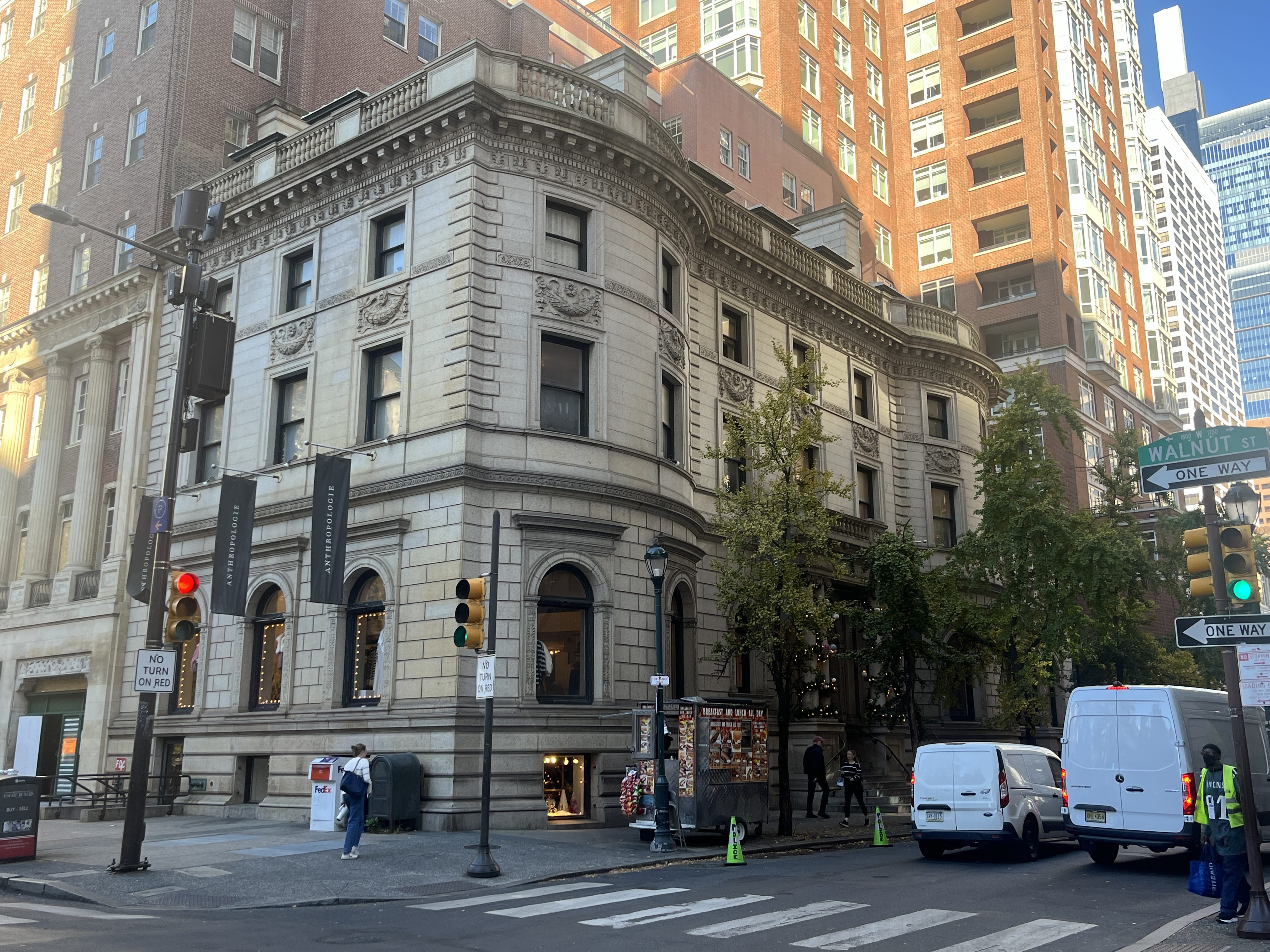
Anthropolgie: Then
Anthony’s youngest daughter Sarah “Sallie” Rozet Drexel Fell Van Rensselaer is the only other Drexel with a still-standing mansion on Rittenhouse Square. In the 1890s, she used the same architects as her brother George to build a four-story, 23,600-square-foot limestone Beaux Arts mansion at 1801 Walnut St. The house became a home to the recently widowed Sallie and her four children and, later, her second husband, Alexander Van Rensselaer.
Like many of her siblings, Sallie continued to be involved with the University after Anthony’s death. Sallie was a member of its first Advisory Board of Women and continued to champion women’s educational opportunities at Drexel; she is the namesake and donor of the University’s Van Rensselaer Hall, which opened in 1931 as a women’s dormitory. In 1895, she dedicated the memorial to her father on the staircase in Main Building’s Great Court. Her first husband, John R. Fell, served on the Drexel Institute’s Board of Trustees from the founding until his death in 1895, and Alexander was a member from 1897 until his death in 1933, serving as president since 1908. After inheriting Anthony’s Runnymede estate in Drexel Hill, Sallie opened it up for recreational use by the Drexel community for about a decade starting in 1910.
When Sallie died in 1929, her New York Times obituary called her house “one of the finest in the city;” Alexander’s New York Times obituary noted that it “served as a brilliant centre [sic] of Philadelphia social life for a quarter of a century.”

On the left is a 1974 public domain photograph from the Prints and Photographs Division of the Library of Congress showing the original Tiffany stained-glass dome before internal construction turned the mansion into a retail space (other photos taken during this time are also publicy available). The photograph on the right shows the same dome as seen today through the lowest level of the Anthropologie looking up though the spiral staircase.
Anthropolgie: Now
The property was sold to the Penn Athletic Club in 1942 and became a clubhouse for the next couple of decades.
In 1974, the abandoned space was gutted and remodeled to become a Design Research department store, which closed in 1979.
In 1982, an Urban Outfitters retail store opened in the location, and sister store Anthropologie replaced it at the turn of the 21st century, occupying the space to this day.
Overlooking Rittenhouse Square, the external façade hasn’t changed as much as the inside, though it is frequently decorated by Anthropologie. The interior still contains some of the original house's original features, including a glass Tiffany & Co. dome and a ceiling with portraits of Italian princes.

Other Drexel Homes ‘Off Rittenhouse Square:’
Some Drexels famously lived "Off Rittenhouse Square," as described in a song from the soundtrack of a Disney movie about the founder’s grandson, Col. Anthony Joseph Drexel Biddle Sr. “The Happiest Millionaire,” a 1967 live-action musical comedy, was inspired by a 1955 book, “My Philadelphia Father,” co-written by Cordelia Drexel Biddle Duke Robertson, the founder’s great-granddaughter. The movie, which was the last one worked on by Walt Disney, featured many hallmarks of other successful Disney movies at the time, though "The Happiest Millionaire" was a flop: the soundtrack was written by the Sherman brothers, of "Mary Poppins" fame, and Anthony Joseph Drexel Biddle Sr. is played by Fred MacMurray, who had starred in previous Disney hits like "The Shaggy Dog" and "The Absent-Minded Professor."
Anthony Joseph Drexel Biddle Sr. famously lived, in real life and in creative works, at 2104 Walnut St., a brownstone that housed his family, his pet alligators and the Christian boxers he taught in his Drexel Biddle Bible Classes. Today, the 125-year-old building houses apartments and a hair salon on the ground floor.
Drexels had first moved “off Rittenhouse Square” a century before that song was written. However, George and Sallie’s mansions remain as two of its few surviving Gilded Age mansions.
- Northeast corner of Rittenhouse Square: Like his brother George, Anthony J. Drexel, Jr. moved here from the Drexel Colony in 1893 after their father’s death. He, his wife Margarita Armstrong Drexel and their four children moved across the street from Sallie. The building was purchased in 1899 and demolished about a dozen years later; Hotel AKA Rittenhouse Square now occupies the site.
- 1804 S. Rittenhouse Square: Anthony’s sister Mary Johanna Drexel Lankenau, her husband John D. Lankenau and their two children lived in this residence from 1861 until they moved to another Drexel property on Rittenhouse Square (more information on that below). An 1891 Frank Furness-designed building still exists and has been occupied for the last 30 years by a dental office.
- 1816 S. Rittenhouse Square: the founder lived here with his wife Ellen and their two infant daughters Emilie and Fannie from 1853 to 1856. That building has been demolished, and the current building is best known for a different former resident and banker: Horace Harding.
- 1826 S. Rittenhouse Square: The founder’s niece Louise Bouvier Drexel Morrell (half-sister to Saint Katharine Drexel) lived here for about a decade in 1888 with her husband Edward de Veaux Morrell. It was later demolished and is now a high-rise.
- 1900 S. Rittenhouse Square: The founder’s parents (Francis Martin and Catherine Hookey Drexel) moved here in the early 1850s with their four remaining unmarried children. (About a decade before, when Anthony was still living at home, the family lived on Chestnut Street near 17th Street, by the city’s then-westernmost border.) After Francis Martin’s death in 1863 and Catherine’s in 1870, Mary Johanna and John Lankenau moved in. After Mary Johanna’s death in 1873, John continued to reside there until his death in 1901; he was the longtime executor of Francis Martin’s will who donated his art collection to Drexel University. A 1920s high-rise was later built in the space, which now houses the 1900 Rittenhouse Square condominiums.
In This Article
Drexel News is produced by
University Marketing and Communications.
